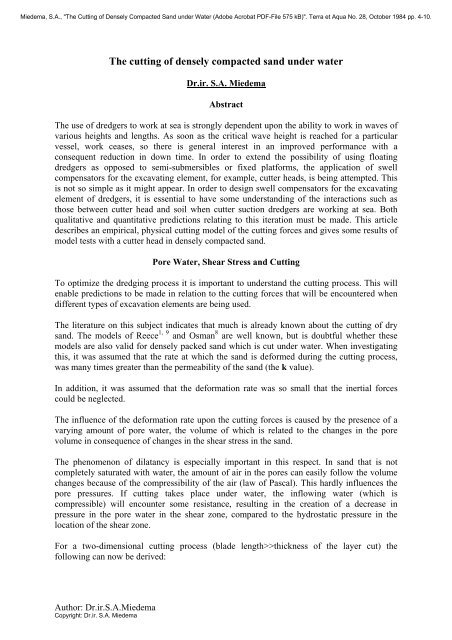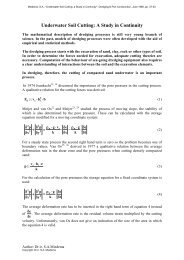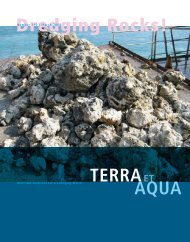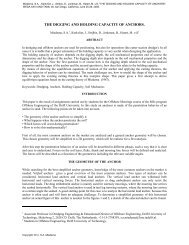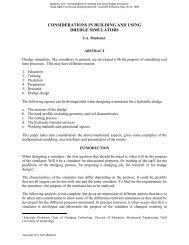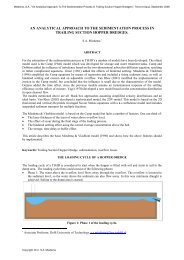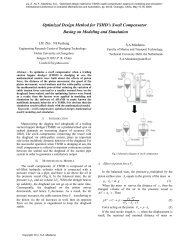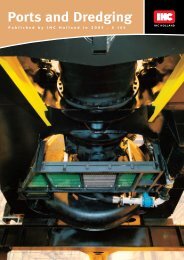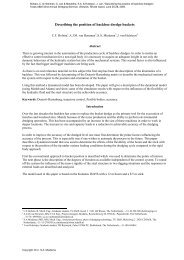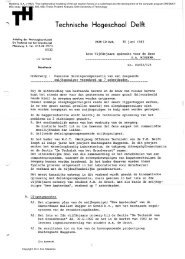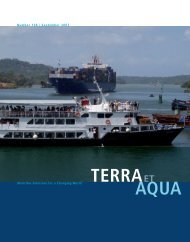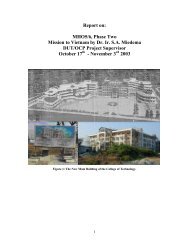The cutting of densely compacted sand under water - Dredging ...
The cutting of densely compacted sand under water - Dredging ...
The cutting of densely compacted sand under water - Dredging ...
You also want an ePaper? Increase the reach of your titles
YUMPU automatically turns print PDFs into web optimized ePapers that Google loves.
Miedema, S.A., "<strong>The</strong> Cutting <strong>of</strong> Densely Compacted Sand <strong>under</strong> Water (Adobe Acrobat PDF-File 575 kB)". Terra et Aqua No. 28, October 1984 pp. 4-10.<strong>The</strong> <strong>cutting</strong> <strong>of</strong> <strong>densely</strong> <strong>compacted</strong> <strong>sand</strong> <strong>under</strong> <strong>water</strong>Dr.ir. S.A. MiedemaAbstract<strong>The</strong> use <strong>of</strong> dredgers to work at sea is strongly dependent upon the ability to work in waves <strong>of</strong>various heights and lengths. As soon as the critical wave height is reached for a particularvessel, work ceases, so there is general interest in an improved performance with aconsequent reduction in down time. In order to extend the possibility <strong>of</strong> using floatingdredgers as opposed to semi-submersibles or fixed platforms, the application <strong>of</strong> swellcompensators for the excavating element, for example, cutter heads, is being attempted. Thisis not so simple as it might appear. In order to design swell compensators for the excavatingelement <strong>of</strong> dredgers, it is essential to have some <strong>under</strong>standing <strong>of</strong> the interactions such asthose between cutter head and soil when cutter suction dredgers are working at sea. Bothqualitative and quantitative predictions relating to this iteration must be made. This articledescribes an empirical, physical <strong>cutting</strong> model <strong>of</strong> the <strong>cutting</strong> forces and gives some results <strong>of</strong>model tests with a cutter head in <strong>densely</strong> <strong>compacted</strong> <strong>sand</strong>.Pore Water, Shear Stress and CuttingTo optimize the dredging process it is important to <strong>under</strong>stand the <strong>cutting</strong> process. This willenable predictions to be made in relation to the <strong>cutting</strong> forces that will be encountered whendifferent types <strong>of</strong> excavation elements are being used.<strong>The</strong> literature on this subject indicates that much is already known about the <strong>cutting</strong> <strong>of</strong> dry<strong>sand</strong>. <strong>The</strong> models <strong>of</strong> Reece 1, 9 and Osman 8 are well known, but is doubtful whether thesemodels are also valid for <strong>densely</strong> packed <strong>sand</strong> which is cut <strong>under</strong> <strong>water</strong>. When investigatingthis, it was assumed that the rate at which the <strong>sand</strong> is deformed during the <strong>cutting</strong> process,was many times greater than the permeability <strong>of</strong> the <strong>sand</strong> (the k value).In addition, it was assumed that the deformation rate was so small that the inertial forcescould be neglected.<strong>The</strong> influence <strong>of</strong> the deformation rate upon the <strong>cutting</strong> forces is caused by the presence <strong>of</strong> avarying amount <strong>of</strong> pore <strong>water</strong>, the volume <strong>of</strong> which is related to the changes in the porevolume in consequence <strong>of</strong> changes in the shear stress in the <strong>sand</strong>.<strong>The</strong> phenomenon <strong>of</strong> dilatancy is especially important in this respect. In <strong>sand</strong> that is notcompletely saturated with <strong>water</strong>, the amount <strong>of</strong> air in the pores can easily follow the volumechanges because <strong>of</strong> the compressibility <strong>of</strong> the air (law <strong>of</strong> Pascal). This hardly influences thepore pressures. If <strong>cutting</strong> takes place <strong>under</strong> <strong>water</strong>, the inflowing <strong>water</strong> (which iscompressible) will encounter some resistance, resulting in the creation <strong>of</strong> a decrease inpressure in the pore <strong>water</strong> in the shear zone, compared to the hydrostatic pressure in thelocation <strong>of</strong> the shear zone.For a two-dimensional <strong>cutting</strong> process (blade length>>thickness <strong>of</strong> the layer cut) thefollowing can now be derived:Author: Dr.ir.S.A.MiedemaCopyright: Dr.ir. S.A. Miedema
Miedema, S.A., "<strong>The</strong> Cutting <strong>of</strong> Densely Compacted Sand <strong>under</strong> Water (Adobe Acrobat PDF-File 575 kB)". Terra et Aqua No. 28, October 1984 pp. 4-10.Figure 1: <strong>The</strong> two-dimensional <strong>cutting</strong> processIf a blade moves a distance <strong>of</strong> Δx in the <strong>sand</strong> (Figure 1), then for the <strong>sand</strong> element in theshear zone:Δ V = Δh⋅ Δx⋅ Δn⋅ L(1)In which:ΔV Volume increase in the <strong>sand</strong> element m 3Δl Length <strong>of</strong> the <strong>sand</strong> element mΔh Δl · sin (β) mβ Angle <strong>of</strong> the shear zone in relation to the direction <strong>of</strong> <strong>cutting</strong> degΔn Increase <strong>of</strong> pore volume in the shear zone, two-dimensional %Δx Movement <strong>of</strong> the blade in a period <strong>of</strong> time Δt mL Length <strong>of</strong> the blade m<strong>The</strong> volume <strong>of</strong> the <strong>water</strong> that must flow into the <strong>sand</strong> element now equals:Author: Dr.ir.S.A.MiedemaCopyright: Dr.ir. S.A. Miedema
Miedema, S.A., "<strong>The</strong> Cutting <strong>of</strong> Densely Compacted Sand <strong>under</strong> Water (Adobe Acrobat PDF-File 575 kB)". Terra et Aqua No. 28, October 1984 pp. 4-10.Δ Q = ΔV / Δt= Δh⋅ Δn⋅ Δx / Δt⋅ L = vc ⋅ Δh⋅ Δn⋅ L(2)In which:ΔQ Flow rate m 3 /sv c Cutting velocity m/sThis is equivalent to:Δ = v ⋅ Δl⋅ L + v ⋅ Δl⋅ L(3)Q w1w2Hence:vw1+ v = v ⋅ Δn⋅sin(β)(4)w2cFrom the theory <strong>of</strong> soil mechanics 10 and the ground<strong>water</strong> mechanic 11 , it is known that:v w *= k ⋅ i (law <strong>of</strong> Darcy) (5)In which:v w Total specific flow rate m/sk * Effective permeability coefficient m/si Gradient <strong>of</strong> <strong>water</strong> pressure -With:i = Δp /( ρ⋅ g ⋅ δ)(6)In which:ΔpPressure drop in the <strong>sand</strong> element in relation to the prevailing hydrostaticpressurePaρ <strong>The</strong> specific mass <strong>of</strong> <strong>water</strong> kg/m 3Author: Dr.ir.S.A.MiedemaCopyright: Dr.ir. S.A. Miedema
Miedema, S.A., "<strong>The</strong> Cutting <strong>of</strong> Densely Compacted Sand <strong>under</strong> Water (Adobe Acrobat PDF-File 575 kB)". Terra et Aqua No. 28, October 1984 pp. 4-10.g <strong>The</strong> gravitational constant m/s 2δ<strong>The</strong> actual path which the <strong>water</strong> must travel from the free, <strong>sand</strong> surface tothe shear zonemThus:Δ p = v ⋅ρ⋅g ⋅ δ /(7)w k *And:vww1 w2⋅ L = (v + v ) ⋅ L(8)Substituting this in equation (4) gives:Δ p = ρ⋅ g ⋅ v ⋅ Δn⋅ sin( β)⋅ δ /(9)c k *<strong>The</strong> average pressure drop in the shear zone can be found by integrating equation (9) over theshear zone, this gives:Δ p = a ⋅ρ⋅ g ⋅ v ⋅ Δn⋅h / k(10)av1c*In which:h <strong>The</strong> thickness <strong>of</strong> the layer cut ma 1 <strong>The</strong> proportionality constant -<strong>The</strong> fall in pressure is governed by a limiting factor. For a specific product <strong>of</strong> <strong>cutting</strong> velocityand cut layer thickness, the drop in pressure will be so great that the absolute pressure in thepores <strong>of</strong> the <strong>sand</strong> element may reach saturated <strong>water</strong> vapor pressure, dependent upon theprevailing environmental conditions. With an environmental temperature <strong>of</strong> 10° C, this <strong>water</strong>vapor pressure is about 12cm <strong>water</strong> column and can thus be disregarded in comparison to theatmospheric pressure. If the saturated <strong>water</strong> vapor pressure in the pores is reached, cavitationwill occur. <strong>The</strong> pressure in the pores cannot decrease further and the pressure drop Δpremains constant with an increasing <strong>cutting</strong> velocity (in the <strong>sand</strong> element in question).Author: Dr.ir.S.A.MiedemaCopyright: Dr.ir. S.A. Miedema
Miedema, S.A., "<strong>The</strong> Cutting <strong>of</strong> Densely Compacted Sand <strong>under</strong> Water (Adobe Acrobat PDF-File 575 kB)". Terra et Aqua No. 28, October 1984 pp. 4-10.Figure 2: Dilatancy during the <strong>cutting</strong> processFrom Figure 2 it can be seen that the distance between a <strong>sand</strong> element in the shear zone andthe free <strong>sand</strong> surface depends upon the location <strong>of</strong> the <strong>sand</strong> element in the dilatancy zone.This means that cavitation begins where the effective path <strong>of</strong> the <strong>water</strong> is the longest. Thiswill be in an area just in front <strong>of</strong> the edge <strong>of</strong> the blade (not at the edge <strong>of</strong> the blade). With anincrease in <strong>cutting</strong> velocity, the cavitation zone will extend until it includes almost the entiredilatancy zone.In the development <strong>of</strong> cavitation in the shear zone, three phases can now be distinguished.Phase 1: <strong>The</strong> <strong>cutting</strong> velocity is low and/or the cut layer is thin. Pressure decreases in thepores, but there is still no cavitation. <strong>The</strong>re is a linear decrease in the average pressure withincreasing <strong>cutting</strong> velocity and the increasing layer thickness.Δ p = a ⋅ρ⋅ g ⋅ v ⋅ Δn⋅h / k(11)av1c*Phase 2: A transitional stage. <strong>The</strong> <strong>cutting</strong> velocity increases further and/or the cut layerbecomes thicker. Local cavitation develops in the dilatancy zone. With a further increase in<strong>cutting</strong> velocity and/or in layer thickness, the cavitation zone continues to extend. <strong>The</strong>pressure no longer decreases in a linear relation to the <strong>cutting</strong> velocity and the cut layerthickness, but in accordance with the following equation.[ a ⋅ρ⋅ g ⋅ Δn⋅ v ⋅h / k + a ⋅ρ⋅ g ⋅(y10) ]Δ pav = a2⋅ 3c * 4 +(12)Author: Dr.ir.S.A.MiedemaCopyright: Dr.ir. S.A. Miedema
Miedema, S.A., "<strong>The</strong> Cutting <strong>of</strong> Densely Compacted Sand <strong>under</strong> Water (Adobe Acrobat PDF-File 575 kB)". Terra et Aqua No. 28, October 1984 pp. 4-10.Phase 3: Cavitation occurring throughout almost the entire dilatancy zone. With increased<strong>cutting</strong> velocity and/or cut layer thickness, the decrease in pressure remains more or lessconstant. At very high <strong>cutting</strong> velocities, cavitation can even occur behind the edge <strong>of</strong> the<strong>cutting</strong> blade.Δ p av = ρ⋅ g ⋅(y+ 10)(13)In which:y Water depth at the <strong>cutting</strong> position ma 2 , a 3 , a 4 Proportionality constants -Figure 3: Under pressure in the pores as a function <strong>of</strong> <strong>cutting</strong> velocity, cut layerthickness and the <strong>water</strong> depth<strong>The</strong>se three phases are shown in Figure 3 and can be approximated by the followingequation:avα 1cα2Δ p = ρ ⋅ g ⋅ Δn⋅ v ⋅ h / k(14)*Author: Dr.ir.S.A.MiedemaCopyright: Dr.ir. S.A. Miedema
Miedema, S.A., "<strong>The</strong> Cutting <strong>of</strong> Densely Compacted Sand <strong>under</strong> Water (Adobe Acrobat PDF-File 575 kB)". Terra et Aqua No. 28, October 1984 pp. 4-10.This approximation is also evident from Figure 3.<strong>The</strong> exponents α 1 and α 2 can vary between 0 and 1. When the cohesion and the initial grainstress are neglected, the average shear stress in the dilatancy zone can be demonstrated by:τav= Δp⋅ tan( ϕ)Thus:F c:: Δ p ⋅h⋅ L(15)In which:ϕ Angle <strong>of</strong> internal friction <strong>of</strong> the <strong>sand</strong> in the shear zone degLLength <strong>of</strong> the blade involved in <strong>cutting</strong>mτ av<strong>The</strong> average shear stress N/m 2For the <strong>cutting</strong> force in phase 1, the following is valid:Fc5c2= a ⋅ ρ ⋅ g ⋅ v ⋅ Δn⋅ h ⋅ L / k(16)*If localized cavitation occurs (phase 2) the following is valid:2[ a ⋅ρ⋅ g ⋅ v ⋅ Δn⋅ h ⋅ L / k + a ⋅ρ⋅ g ⋅ (y + 10) ⋅ h ⋅ L]Fc= a6⋅ 3 c* 4(17)With fully developed cavitation throughout the dilatancy zone (phase 3), the followingequation is valid:Fc7= a ⋅ρ⋅g ⋅(y+ 10) ⋅h⋅ L(18)<strong>The</strong> three phases can be approximated by the following equation:Fcα 1cα2+1= a ⋅ ρ⋅ g ⋅ Δn⋅ L ⋅ v ⋅ h / k(19)*In which:Author: Dr.ir.S.A.MiedemaCopyright: Dr.ir. S.A. Miedema
Miedema, S.A., "<strong>The</strong> Cutting <strong>of</strong> Densely Compacted Sand <strong>under</strong> Water (Adobe Acrobat PDF-File 575 kB)". Terra et Aqua No. 28, October 1984 pp. 4-10.a 5 , a 6 , a 7 , a Proportionality constants -F c Cutting force NThis equation forms the basis for the method <strong>of</strong> calculating the <strong>cutting</strong> forces required for theexcavation <strong>of</strong> <strong>densely</strong> <strong>compacted</strong> <strong>sand</strong> with a cutter head.Application <strong>of</strong> the Cutting Force Model to a CutterheadWhen using this model to make an estimate <strong>of</strong> the <strong>cutting</strong> forces, which are obtained inpractice, it is necessary to know the <strong>cutting</strong> velocity, the <strong>cutting</strong> direction, the cut layerthickness, the length <strong>of</strong> the blade involved in <strong>cutting</strong> and the permeability coefficient <strong>of</strong> the<strong>sand</strong> upon which the blades are acting.As the cut layer thickness and the <strong>cutting</strong> velocity are a function, amongst others, <strong>of</strong> theposition <strong>of</strong> the blade in the breach, the shape <strong>of</strong> the cutter head and <strong>of</strong> time, and as thepermeability coefficient is not necessarily constant, it is not easy to make an exact calculation<strong>of</strong> the forces acting on the cutter head. For example, the permeability after shear is greaterthan the permeability before shear. But it is possible by a good choice <strong>of</strong> characteristic layerthickness, length <strong>of</strong> the blade involved in <strong>cutting</strong> and the <strong>cutting</strong> velocity, to obtain a goodapproximation <strong>of</strong> the loads on the cutter head by substituting the characteristic values inequation (19). <strong>The</strong> relation which is found, however, is not purely theoretical.Photo 1: A view <strong>of</strong> the laboratory test standAuthor: Dr.ir.S.A.MiedemaCopyright: Dr.ir. S.A. Miedema
Miedema, S.A., "<strong>The</strong> Cutting <strong>of</strong> Densely Compacted Sand <strong>under</strong> Water (Adobe Acrobat PDF-File 575 kB)". Terra et Aqua No. 28, October 1984 pp. 4-10.Selection <strong>of</strong> the Characteristic ParametersIn selecting the characteristic cut layer thickness, <strong>cutting</strong> velocity and length <strong>of</strong> the bladeinvolved in <strong>cutting</strong>, it is important that these three parameters can be easily derived from anumber <strong>of</strong> known values. <strong>The</strong> <strong>cutting</strong> velocity is determined by the number <strong>of</strong> revolutions <strong>of</strong>the cutter head, the swing speed <strong>of</strong> the cutter suction dredger and the diameter <strong>of</strong> the cutterhead. In fact, the velocity at any one time is the sum <strong>of</strong> the vectors <strong>of</strong> the momentarycircumferential velocity <strong>of</strong> a blade and the swing velocity. <strong>The</strong> circumferential velocitychanges direction continually so the velocity <strong>of</strong> a blade is not constant in time, with respect todirection or speed (Figure 4). As the swing velocity is 6 to 10 times smaller than thecircumferential velocity, it will have little influence upon the <strong>cutting</strong> velocity. <strong>The</strong>circumferential velocity <strong>of</strong> the cutter head is selected for the characteristic <strong>cutting</strong> velocity.vc= 2⋅π ⋅ R ⋅n/ 60(20)ccIn which:n c the number <strong>of</strong> revolutions <strong>of</strong> the cutter head rpmR c <strong>The</strong> average radius <strong>of</strong> the cutter head mv c =v cf <strong>The</strong> characteristic <strong>cutting</strong> velocity m/sFigure 4: <strong>The</strong> variation <strong>of</strong> the <strong>cutting</strong> velocityAuthor: Dr.ir.S.A.MiedemaCopyright: Dr.ir. S.A. Miedema
Miedema, S.A., "<strong>The</strong> Cutting <strong>of</strong> Densely Compacted Sand <strong>under</strong> Water (Adobe Acrobat PDF-File 575 kB)". Terra et Aqua No. 28, October 1984 pp. 4-10.<strong>The</strong> cut layer thickness is also determined by the number <strong>of</strong> revolutions, the cutter diameter,the swing velocity and the number <strong>of</strong> blades on the cutter head. Figure 5 illustrates how thecut layer thickness varies as a function <strong>of</strong> time and the position <strong>of</strong> the blade. This figure alsoshows the epicyclic path <strong>of</strong> the blades for <strong>under</strong><strong>cutting</strong> and over<strong>cutting</strong>. <strong>The</strong> figure illustrateshow the cut layer thickness decreases for the overcut, from a maximum value, when the bladeenters a breach, to almost 0 at the moment that a blade leaves the breach. For <strong>under</strong><strong>cutting</strong>,the reverse is true. When <strong>under</strong><strong>cutting</strong>, the shape <strong>of</strong> the cut layer is clearly different from theshape formed when over<strong>cutting</strong> (Figure 6), which is <strong>of</strong> consequence with regard to the <strong>cutting</strong>forces.<strong>The</strong> area <strong>of</strong> the cross section cut, however, is characteristic for each blade. This is shown inFigure 7. This area can be determined by:A = v ⋅ 60⋅B /(n ⋅ z)(21)scIn which:v s <strong>The</strong> swing velocity m/sz <strong>The</strong> number <strong>of</strong> blades -B <strong>The</strong> height <strong>of</strong> the breach mFigure 5: <strong>The</strong> epicyclic path <strong>of</strong> the blades<strong>The</strong> path followed by the blade in the breach, if the effect <strong>of</strong> the swing speed is discounted,is:[(Rc − B) / Rc] ⋅ Rcs = arccos(22)Author: Dr.ir.S.A.MiedemaCopyright: Dr.ir. S.A. Miedema
Miedema, S.A., "<strong>The</strong> Cutting <strong>of</strong> Densely Compacted Sand <strong>under</strong> Water (Adobe Acrobat PDF-File 575 kB)". Terra et Aqua No. 28, October 1984 pp. 4-10.Thus the average cut layer thickness is:s[ n ⋅ z ⋅ R ⋅ arccos[ (R − B) / R]h = A / s = v ⋅ 60⋅B /(23)ccccIn which:h <strong>The</strong> characteristic cut layer thickness mSince, with a particular ratio between swing velocity and number <strong>of</strong> revolutions, the shape <strong>of</strong>the cut layer is fixed (Figure 6), equation (23) can be used for a characteristic cut layerthickness, Figure 6 also shows that as the ratio between the circumferential velocity and theswing velocity increases, the shapes <strong>of</strong> the cut layers formed during over<strong>cutting</strong> graduallybecome more similar.<strong>The</strong> part <strong>of</strong> the blade involved in <strong>cutting</strong> depends on size and shape <strong>of</strong> the blades and on thecross section <strong>of</strong> the cutter head in the breach (the theoretical cut surface as in Figure 8).Apparently, the theoretical cut surface in the working area increases almost linearly with theheight <strong>of</strong> the breach and the size <strong>of</strong> the step. A reasonable assumption would be that there is alinear increase in the <strong>cutting</strong> blade length in relation to the theoretical cut surface. For thecharacteristic <strong>cutting</strong> length <strong>of</strong> the blade, the following equation is given:L = 0.25⋅A ⋅ z /(24)th R cIn which:L <strong>The</strong> characteristic <strong>cutting</strong> blade length mA th <strong>The</strong> theoretical cut surface m 2For a disc-bottom cutter head with vertical blades it can be shown that the actual <strong>cutting</strong>blade length is the same as the characteristic <strong>cutting</strong> blade length. For all other cutter headsthe actual <strong>cutting</strong> blade length is greater.With the calculated characteristic <strong>cutting</strong> velocity (eqn. 20), cut layer thickness (eqn. 23) and<strong>cutting</strong> blade length (eqn. 24) substituted in equation 19, a provisional <strong>cutting</strong> force modelcan be set up. <strong>The</strong> only unknown parameter in this model is the permeability coefficient.Other soil mechanical parameters are included in the proportionality constants, such as angle<strong>of</strong> internal friction and dilatancy angle. If it is assumed that localized cavitation occurs in thecut layers and across the length <strong>of</strong> the blade, then equation 25 is valid.α1ci = ai⋅[ 2⋅π ⋅ nc⋅ Rc/ 60] ⋅[ vs⋅ 60⋅B /[ nc⋅ z ⋅ Rc⋅arccos[ (Rc− B) / Rc][ 0.25⋅A ⋅ z / R ] ⋅[ 1/ k ]F⋅thc*α2+1(25)In which:Author: Dr.ir.S.A.MiedemaCopyright: Dr.ir. S.A. Miedema
Miedema, S.A., "<strong>The</strong> Cutting <strong>of</strong> Densely Compacted Sand <strong>under</strong> Water (Adobe Acrobat PDF-File 575 kB)". Terra et Aqua No. 28, October 1984 pp. 4-10.i=1 gives the radial force perpendicular to the swing directioni=2 gives the radial force in the swing directioni=3 gives the axial forceFor the driving torque, equation 26 is valid:α1c = am⋅ Rc⋅[ 2⋅π ⋅nc⋅ Rc/ 60] ⋅[ vs⋅ 60⋅B /[ nc⋅ z ⋅ Rc⋅ arccos[ (Rc− B) / Rc][ 0.25⋅A ⋅ z / R ] ⋅[ 1/ k ]M⋅thc*α2+1(26)<strong>The</strong> term (ρ · g · Δn) <strong>of</strong> equation 19 is included in the proportionality constants.Figure 6: <strong>The</strong> shape <strong>of</strong> the cut layerVerification <strong>of</strong> the Cutting Force ModelTo test the validity <strong>of</strong> the <strong>cutting</strong> force model a series <strong>of</strong> tests was carried out in thelaboratory "<strong>The</strong> Technology <strong>of</strong> Soil Movement" <strong>of</strong> the Delft University <strong>of</strong> Technology, using<strong>compacted</strong> <strong>sand</strong> with a d50 <strong>of</strong> 150 μm and a cone resistance <strong>of</strong> around 7 MPa. From thesetests the exponents <strong>of</strong> the characteristic cut layer thickness, <strong>cutting</strong> velocity and thecoefficient <strong>of</strong> proportionality were determined for seven cutter heads (scale 1:6, diameter 400mm).Author: Dr.ir.S.A.MiedemaCopyright: Dr.ir. S.A. Miedema
Miedema, S.A., "<strong>The</strong> Cutting <strong>of</strong> Densely Compacted Sand <strong>under</strong> Water (Adobe Acrobat PDF-File 575 kB)". Terra et Aqua No. 28, October 1984 pp. 4-10.Table I shows a summary <strong>of</strong> the over<strong>cutting</strong> tests and Table II <strong>of</strong> the <strong>under</strong><strong>cutting</strong> tests.Photos 2 and 3 show two <strong>of</strong> the cutter heads which were used in the tests.During the laboratory tests it also appeared that for the type <strong>of</strong> <strong>sand</strong> used the <strong>cutting</strong> force<strong>sand</strong> the driving torque increased almost linearly with the cone resistance <strong>of</strong> the <strong>sand</strong>. It wastherefore decided to make provisional modifications to the model to give:Fi= a ⋅ viα1c⋅ hα2+1⋅ L ⋅ qc(27)AndMc= am⋅ Rc⋅ vα1c⋅ hα2+1⋅ L ⋅ qc(28)In which:q c Cone resistance MPa<strong>The</strong> tables I and II refer to these equations.Figure 7: <strong>The</strong> area <strong>of</strong> the cross-section <strong>of</strong> a cut layerAuthor: Dr.ir.S.A.MiedemaCopyright: Dr.ir. S.A. Miedema
Miedema, S.A., "<strong>The</strong> Cutting <strong>of</strong> Densely Compacted Sand <strong>under</strong> Water (Adobe Acrobat PDF-File 575 kB)". Terra et Aqua No. 28, October 1984 pp. 4-10.Figure 8: <strong>The</strong> theoretical cut surfacePhoto 2: A normal crown cutterhead used in the testsAuthor: Dr.ir.S.A.MiedemaCopyright: Dr.ir. S.A. Miedema
Miedema, S.A., "<strong>The</strong> Cutting <strong>of</strong> Densely Compacted Sand <strong>under</strong> Water (Adobe Acrobat PDF-File 575 kB)". Terra et Aqua No. 28, October 1984 pp. 4-10.Photo 3: A flattened cutterhead with disc wheel shaped blades used in the testsConclusions<strong>The</strong>re was a good correlation between the mathematically derived <strong>cutting</strong> force model andthe results <strong>of</strong> the laboratory tests. Although a number <strong>of</strong> simplifications are applied, it appearsthat the model is reliable and that it can be generally applied to cutter heads, with the provisothat if an accurate prediction <strong>of</strong> the <strong>cutting</strong> forces is to be made, the coefficients andexponents for the equations must be determined by model tests for each type <strong>of</strong> cutter head.<strong>The</strong>se equations lie at the basis <strong>of</strong> extended equations in which the effect <strong>of</strong> axial and radialmovements <strong>of</strong> the cutter head, perpendicular to the swing direction, have been included.<strong>The</strong>se extended equations are implemented in the computer program "DREDMO" with whichthe nonlinear behaviour <strong>of</strong> a cutter suction dredger in swell can be determined (3, 4, 5 and 6)."DREDMO" can be used to investigate the effectiveness <strong>of</strong> various types <strong>of</strong> swellcompensators on cutter suction dredgers. <strong>The</strong> main issue, however, is the soil cutter headinteraction on which the behaviour <strong>of</strong> each swell compensator depends. It is thus veryimportant to have a good <strong>under</strong>standing <strong>of</strong> the <strong>cutting</strong> process and to be able to make anestimate <strong>of</strong> the <strong>cutting</strong> forces.Table I: Summary <strong>of</strong> over<strong>cutting</strong> testswith several types <strong>of</strong> cutter heads.Table II: Summary <strong>of</strong> <strong>under</strong><strong>cutting</strong> testswith several types <strong>of</strong> cutter heads.Variation in swing velocity 7-35cm/sec Variation in swing velocity 4-31cm/secVariation in revolutions 24-180 rpm Variation in revolutions 25-180 rpmTotal number <strong>of</strong> tests 227 Total number <strong>of</strong> tests 185Author: Dr.ir.S.A.MiedemaCopyright: Dr.ir. S.A. Miedema
Miedema, S.A., "<strong>The</strong> Cutting <strong>of</strong> Densely Compacted Sand <strong>under</strong> Water (Adobe Acrobat PDF-File 575 kB)". Terra et Aqua No. 28, October 1984 pp. 4-10.Correlation coefficients 0.94-0.99 Correlation coefficients 0.91-0.99Bibliography1. Hettiaratchi, D.R.P. & Reece, A.R., "Symmetrical Three-dimensional Soil Failure". J.Terramech. (1964)4, (3), pp45-67.2. Joanknecht, L.W.F., "A Review <strong>of</strong> Dredge Cutter Head Modelling and Performance".Proc. WODCON VII, San Francisco, Califonia, USA., 1976.3. Keuning, P.J. & Journee, J., "Calculation Method for the Behaviour <strong>of</strong> a CutterSuction Dredger Oparating in Irregular Waves". Proc. WODCON X, Singapore 1983.4. Koning, J.de & Miedema, S.A. & Zwartbol, A., "Soil/Cutterhead Interaction <strong>under</strong>Wave Conditions". Proc. WODCON X, Singapore, 1983.5. Miedema, S.A., "De interactie tussen snijkop en grond in zeegang". Proc. Baggerdag19/11/1982, T.H. Delft, 1982.6. Miedema, S.A., "Computersimulatie baggerschepen". De Ingenieur, Dec.1983.(Kivi/Misset):7. Os, A.G. van, "Behaviour <strong>of</strong> Soil when excavated <strong>under</strong> <strong>water</strong>". International CourseModern <strong>Dredging</strong>. June 1977, <strong>The</strong> Hague, <strong>The</strong> Netherlands.8. Osman, M.S., "<strong>The</strong> Mechanics <strong>of</strong> Soil Cutting Blades". J.A.E.R. 9 (4). Pp.313-328,1964.9. Reece, A.R., "<strong>The</strong> Fundamental Equation <strong>of</strong> Earth Moving Machinery". Proc. Symp.On Earth Moving Machinery. Institute <strong>of</strong> Mechanical Engineering, London, 1965.10. Terzaghi, K. & Peck, R.B., "Soil Mechanics in Engineering Practise". John Wiley &Sons, Inc., 1967.11. Verruijt, A., "<strong>The</strong>ory <strong>of</strong> Ground<strong>water</strong> Flow". Macmillan, London, 1970.List <strong>of</strong> Symbols useda 1 ,a 2 ,a 3 ,a 4 <strong>The</strong> proportionality constants -A th <strong>The</strong> theoretical cut surface. m 2B <strong>The</strong> height <strong>of</strong> the breach. mF c Cutting force. kNg <strong>The</strong> gravitational constant. m/sec 2h Thickness <strong>of</strong> the layer cut. mΔh Height <strong>of</strong> the <strong>sand</strong> element, Δh = Δl·sin(β). mi Gradient <strong>of</strong> <strong>water</strong> pressure. -k * Effective permeability coefficient. m/secΔl Length <strong>of</strong> the <strong>sand</strong> element. mL Length <strong>of</strong> the blade involved in <strong>cutting</strong>. mn c <strong>The</strong> number <strong>of</strong> revolutions <strong>of</strong> the cutterhead. rpmΔn Increase <strong>of</strong> pore volume in the shear zone, two dimensional. %ΔpPressure drop in the <strong>sand</strong> element in relation to the prevailinghydrostatic pressure.kPaR c <strong>The</strong> average radius <strong>of</strong> the cutterhead. mAuthor: Dr.ir.S.A.MiedemaCopyright: Dr.ir. S.A. Miedema
Miedema, S.A., "<strong>The</strong> Cutting <strong>of</strong> Densely Compacted Sand <strong>under</strong> Water (Adobe Acrobat PDF-File 575 kB)". Terra et Aqua No. 28, October 1984 pp. 4-10.q c Cone resistance. kPaΔQ Flow rate. m 3 /secv c ,v cf Cutting velocity. m/secv s <strong>The</strong> swing velocity. m/secv w Total specific flow rate. m/secΔV Volume increase in the <strong>sand</strong> element. m 3Δx Movement <strong>of</strong> the blade in a period <strong>of</strong> time Δt. my Water depth at the <strong>cutting</strong> position. mz <strong>The</strong> number <strong>of</strong> blades. -β Angle <strong>of</strong> the shear zone in relation to the direction <strong>of</strong> <strong>cutting</strong>. deg.ϕ Angle <strong>of</strong> internal friction <strong>of</strong> the <strong>sand</strong> in the shear zone. deg.δ<strong>The</strong> actual path which the <strong>water</strong> must travel from the free <strong>sand</strong>surface to the shear zone.mρ <strong>The</strong> specific mass <strong>of</strong> the <strong>water</strong>. kg/m 3τ av <strong>The</strong> average shear stress. kPaAuthor: Dr.ir.S.A.MiedemaCopyright: Dr.ir. S.A. Miedema
Bibliography Dr.ir. S.A. Miedema 1980-20101. Koert, P. & Miedema, S.A., "Report on the field excursion to the USA April 1981"(PDF in Dutch 27.2 MB). Delft University <strong>of</strong> Technology, 1981, 48 pages.2. Miedema, S.A., "<strong>The</strong> flow <strong>of</strong> dredged slurry in and out hoppers and the settlementprocess in hoppers" (PDF in Dutch 37 MB). ScO/81/105, Delft University <strong>of</strong>Technology, 1981, 147 pages.3. Miedema, S.A., "<strong>The</strong> soil reaction forces on a crown cutterhead on a swellcompensated ladder" (PDF in Dutch 19 MB). LaO/81/97, Delft University <strong>of</strong>Technology, 1981, 36 pages.4. Miedema, S.A., "Computer program for the determination <strong>of</strong> the reaction forces on acutterhead, resulting from the motions <strong>of</strong> the cutterhead" (PDF in Dutch 11 MB).Delft Hydraulics, 1981, 82 pages.5. Miedema, S.A. "<strong>The</strong> mathematical modeling <strong>of</strong> the soil reaction forces on acutterhead and the development <strong>of</strong> the computer program DREDMO" (PDF in Dutch25 MB). CO/82/125, Delft University <strong>of</strong> Technology, 1982, with appendices 600pages.6. Miedema, S.A.,"<strong>The</strong> Interaction between Cutterhead and Soil at Sea" (In Dutch).Proc. <strong>Dredging</strong> Day November 19th, Delft University <strong>of</strong> Technology 1982.7. Miedema, S.A., "A comparison <strong>of</strong> an <strong>under</strong><strong>water</strong> centrifugal pump and an ejectorpump" (PDF in Dutch 3.2 MB). Delft University <strong>of</strong> Technology, 1982, 18 pages.8. Miedema, S.A., "Computer simulation <strong>of</strong> <strong>Dredging</strong> Vessels" (In Dutch). DeIngenieur, Dec. 1983. (Kivi/Misset).9. Koning, J. de, Miedema, S.A., & Zwartbol, A., "Soil/Cutterhead Interaction <strong>under</strong>Wave Conditions (Adobe Acrobat PDF-File 1 MB)". Proc. WODCON X, Singapore1983.10. Miedema, S.A. "Basic design <strong>of</strong> a swell compensated cutter suction dredge with axialand radial compensation on the cutterhead" (PDF in Dutch 20 MB). CO/82/134, DelftUniversity <strong>of</strong> Technology, 1983, 64 pages.11. Miedema, S.A., "Design <strong>of</strong> a seagoing cutter suction dredge with a swell compensatedladder" (PDF in Dutch 27 MB). IO/83/107, Delft University <strong>of</strong> Technology, 1983, 51pages.12. Miedema, S.A., "Mathematical Modeling <strong>of</strong> a Seagoing Cutter Suction Dredge" (InDutch). Published: <strong>The</strong> Hague, 18-9-1984, KIVI Lectures, Section Under WaterTechnology.13. Miedema, S.A., "<strong>The</strong> Cutting <strong>of</strong> Densely Compacted Sand <strong>under</strong> Water (AdobeAcrobat PDF-File 575 kB)". Terra et Aqua No. 28, October 1984 pp. 4-10.14. Miedema, S.A., "Longitudinal and Transverse Swell Compensation <strong>of</strong> a CutterSuction Dredge" (In Dutch). Proc. <strong>Dredging</strong> Day November 9th 1984, DelftUniversity <strong>of</strong> Technology 1984.15. Miedema, S.A., "Compensation <strong>of</strong> Velocity Variations". Patent application no.8403418, Hydromeer B.V. Oosterhout, 1984.16. Miedema, S.A., "Mathematical Modeling <strong>of</strong> the Cutting <strong>of</strong> Densely Compacted SandUnder Water". <strong>Dredging</strong> & Port Construction, July 1985, pp. 22-26.17. Miedema, S.A., "Derivation <strong>of</strong> the Differential Equation for Sand Pore Pressures".<strong>Dredging</strong> & Port Construction, September 1985, pp. 35.18. Miedema, S.A., "<strong>The</strong> Application <strong>of</strong> a Cutting <strong>The</strong>ory on a <strong>Dredging</strong> Wheel (AdobeAcrobat 4.0 PDF-File 745 kB)". Proc. WODCON XI, Brighton 1986.19. Miedema, S.A., "Under<strong>water</strong> Soil Cutting: a Study in Continuity". <strong>Dredging</strong> & PortConstruction, June 1986, pp. 47-53.
37. Miedema, S.A. & Becker, S., "<strong>The</strong> Use <strong>of</strong> Modeling and Simulation in the <strong>Dredging</strong>Industry, in Particular the Closing Process <strong>of</strong> Clamshell Dredges", CEDA <strong>Dredging</strong>Days 1993, Amsterdam, Holland, 1993.38. Miedema, S.A., "On the Snow-Plough Effect when Cutting Water Saturated Sandwith Inclined Straight Blades (Adobe Acrobat 4.0 PDF-File 503 kB)". ASCE Proc.<strong>Dredging</strong> 94, Orlando, Florida, USA, November 1994.Additional Measurement Graphs. (Adobe Acrobat 4.0 PDF-File 209 kB).39. Riet, E. van, Matousek, V. & Miedema, S.A., "A Reconstruction <strong>of</strong> and SensitivityAnalysis on the Wilson Model for Hydraulic Particle Transport (Adobe Acrobat 4.0PDF-File 50 kB)". Proc. 8th Int. Conf. on Transport and Sedimentation <strong>of</strong> SolidParticles, 24-26 January 1995, Prague, Czech Republic.40. Vlasblom, W.J. & Miedema, S.A., "A <strong>The</strong>ory for Determining Sedimentation andOverflow Losses in Hoppers (Adobe Acrobat 4.0 PDF-File 304 kB)". Proc.WODCON IV, November 1995, Amsterdam, <strong>The</strong> Netherlands 1995.41. Miedema, S.A., "Production Estimation Based on Cutting <strong>The</strong>ories for Cutting WaterSaturated Sand (Adobe Acrobat 4.0 PDF-File 423 kB)". Proc. WODCON IV,November 1995, Amsterdam, <strong>The</strong> Netherlands 1995.Additional Specific Energy and Production Graphs. (Adobe Acrobat 4.0 PDF-File 145kB).42. Riet, E.J. van, Matousek, V. & Miedema, S.A., "A <strong>The</strong>oretical Description andNumerical Sensitivity Analysis on Wilson's Model for Hydraulic Transport inPipelines (Adobe Acrobat 4.0 PDF-File 50 kB)". Journal <strong>of</strong> Hydrology &Hydromechanics, Slovak Ac. <strong>of</strong> Science, Bratislava, June 1996.43. Miedema, S.A. & Vlasblom, W.J., "<strong>The</strong>ory for Hopper Sedimentation (AdobeAcrobat 4.0 PDF-File 304 kB)". 29th Annual Texas A&M <strong>Dredging</strong> Seminar. NewOrleans, June 1996.44. Miedema, S.A., "Modeling and Simulation <strong>of</strong> the Dynamic Behavior <strong>of</strong> aPump/Pipeline System (Adobe Acrobat 4.0 PDF-File 318 kB)". 17th Annual Meeting& Technical Conference <strong>of</strong> the Western <strong>Dredging</strong> Association. New Orleans, June1996.45. Miedema, S.A., "Education <strong>of</strong> Mechanical Engineering, an Integral Vision". FacultyO.C.P., Delft University <strong>of</strong> Technology, 1997 (in Dutch).46. Miedema, S.A., "Educational Policy and Implementation 1998-2003 (versions 1998,1999 and 2000) (Adobe Acrobat 4.0 PDF_File 195 kB)". Faculty O.C.P., DelftUniversity <strong>of</strong> Technology, 1998, 1999 and 2000 (in Dutch).47. Keulen, H. van & Miedema, S.A. & Werff, K. van der, "Redesigning the curriculum<strong>of</strong> the first three years <strong>of</strong> the mechanical engineering curriculum". Proceedings <strong>of</strong> theInternational Seminar on Design in Engineering Education, SEFI-Document no.21,page 122, ISBN 2-87352-024-8, Editors: V. John & K. Lassithiotakis, Odense, 22-24October 1998.48. Miedema, S.A. & Klein Woud, H.K.W. & van Bemmel, N.J. & Nijveld, D., "SelfAssesment Educational Programme Mechanical Engineering (Adobe Acrobat 4.0PDF-File 400 kB)". Faculty O.C.P., Delft University <strong>of</strong> Technology, 1999.49. Van Dijk, J.A. & Miedema, S.A. & Bout, G., "Curriculum Development MechanicalEngineering". MHO 5/CTU/DUT/Civil Engineering. Cantho University Vietnam,CICAT Delft, April 1999.50. Miedema, S.A., "Considerations in building and using dredge simulators (AdobeAcrobat 4.0 PDF-File 296 kB)". Texas A&M 31st Annual <strong>Dredging</strong> Seminar.Louisville Kentucky, May 16-18, 1999.
51. Miedema, S.A., "Considerations on limits <strong>of</strong> dredging processes (Adobe Acrobat 4.0PDF-File 523 kB)". 19th Annual Meeting & Technical Conference <strong>of</strong> the Western<strong>Dredging</strong> Association. Louisville Kentucky, May 16-18, 1999.52. Miedema, S.A. & Ruijtenbeek, M.G. v.d., "Quality management in reality","Kwaliteitszorg in de praktijk". AKO conference on quality management ineducation. Delft University <strong>of</strong> Technology, November 3rd 1999.53. Miedema, S.A., "Curriculum Development Mechanical Engineering (Adobe Acrobat4.0 PDF-File 4 MB)". MHO 5-6/CTU/DUT. Cantho University Vietnam, CICATDelft, Mission October 1999.54. Vlasblom, W.J., Miedema, S.A., Ni, F., "Course Development on Topic 5: <strong>Dredging</strong>Technology, <strong>Dredging</strong> Equipment and <strong>Dredging</strong> Processes". Delft University <strong>of</strong>Technology and CICAT, Delft July 2000.55. Miedema, S.A., Vlasblom, W.J., Bian, X., "Course Development on Topic 5:<strong>Dredging</strong> Technology, Power Drives, Instrumentation and Automation". DelftUniversity <strong>of</strong> Technology and CICAT, Delft July 2000.56. Randall, R. & Jong, P. de & Miedema, S.A., "Experience with cutter suction dredgesimulator training (Adobe Acrobat 4.0 PDF-File 1.1 MB)". Texas A&M 32nd Annual<strong>Dredging</strong> Seminar. Warwick, Rhode Island, June 25-28, 2000.57. Miedema, S.A., "<strong>The</strong> modelling <strong>of</strong> the swing winches <strong>of</strong> a cutter dredge in relationwith simulators (Adobe Acrobat 4.0 PDF-File 814 kB)". Texas A&M 32nd Annual<strong>Dredging</strong> Seminar. Warwick, Rhode Island, June 25-28, 2000.58. H<strong>of</strong>stra, C. & Hemmen, A. van & Miedema, S.A. & Hulsteyn, J. van, "Describing theposition <strong>of</strong> backhoe dredges (Adobe Acrobat 4.0 PDF-File 257 kB)". Texas A&M32nd Annual <strong>Dredging</strong> Seminar. Warwick, Rhode Island, June 25-28, 2000.59. Miedema, S.A., "Automation <strong>of</strong> a Cutter Dredge, Applied to the Dynamic Behaviour<strong>of</strong> a Pump/Pipeline System (Adobe Acrobat 4.0 PDF-File 254 kB)". Proc. WODCONVI, April 2001, Kuala Lumpur, Malaysia 2001.60. Heggeler, O.W.J. ten, Vercruysse, P.M., Miedema, S.A., "On the Motions <strong>of</strong> SuctionPipe Constructions a Dynamic Analysis (Adobe Acrobat 4.0 PDF-File 110 kB)".Proc. WODCON VI, April 2001, Kuala Lumpur, Malaysia 2001.61. Miedema, S.A. & Zhao Yi, "An Analytical Method <strong>of</strong> Pore Pressure Calculationswhen Cutting Water Saturated Sand (Adobe Acrobat PDF-File 2.2 MB)". TexasA&M 33nd Annual <strong>Dredging</strong> Seminar, June 2001, Houston, USA 2001.62. Miedema, S.A., "A Numerical Method <strong>of</strong> Calculating the Dynamic Behaviour <strong>of</strong>Hydraulic Transport (Adobe Acrobat PDF-File 246 kB)". 21st Annual Meeting &Technical Conference <strong>of</strong> the Western <strong>Dredging</strong> Association, June 2001, Houston,USA 2001.63. Zhao Yi, & Miedema, S.A., "Finite Element Calculations To Determine <strong>The</strong> PorePressures When Cutting Water Saturated Sand At Large Cutting Angles (AdobeAcrobat PDF-File 4.8 MB)". CEDA <strong>Dredging</strong> Day 2001, November 2001,Amsterdam, <strong>The</strong> Netherlands.64. Miedema, S.A., "Mission Report Cantho University". MHO5/6, Phase Two, Missionto Vietnam by Dr.ir. S.A. Miedema DUT/OCP Project Supervisor, 27 September-8October 2001, Delft University/CICAT.65. (Zhao Yi), & (Miedema, S.A.),""(Finite Element Calculations To Determine <strong>The</strong> Pore Pressures When Cutting Water
Saturated Sand At Large Cutting Angles (Adobe Acrobat PDF-File 4.8 MB))". To bepublished in 2002.66. Miedema, S.A., & Riet, E.J. van, & Matousek, V., "<strong>The</strong>oretical Description AndNumerical Sensitivity Analysis On Wilson Model For Hydraulic Transport Of SolidsIn Pipelines (Adobe Acrobat PDF-File 147 kB)". WEDA Journal <strong>of</strong> <strong>Dredging</strong>Engineering, March 2002.67. Miedema, S.A., & Ma, Y., "<strong>The</strong> Cutting <strong>of</strong> Water Saturated Sand at Large CuttingAngles (Adobe Acrobat PDF-File 3.6 MB)". Proc. <strong>Dredging</strong>02, May 5-8, Orlando,Florida, USA.68. Miedema, S.A., & Lu, Z., "<strong>The</strong> Dynamic Behavior <strong>of</strong> a Diesel Engine (AdobeAcrobat PDF-File 363 kB)". Proc. WEDA XXII Technical Conference & 34th TexasA&M <strong>Dredging</strong> Seminar, June 12-15, Denver, Colorado, USA.69. Miedema, S.A., & He, Y., "<strong>The</strong> Existance <strong>of</strong> Kinematic Wedges at Large CuttingAngles (Adobe Acrobat PDF-File 4 MB)". Proc. WEDA XXII Technical Conference& 34th Texas A&M <strong>Dredging</strong> Seminar, June 12-15, Denver, Colorado, USA.70. Ma, Y., Vlasblom, W.J., Miedema, S.A., Matousek, V., "Measurement <strong>of</strong> Density andVelocity in Hydraulic Transport using Tomography". <strong>Dredging</strong> Days 2002, <strong>Dredging</strong>without boundaries, Casablanca, Morocco, V64-V73, 22-24 October 2002.71. Ma, Y., Miedema, S.A., Vlasblom, W.J., "<strong>The</strong>oretical Simulation <strong>of</strong> theMeasurements Process <strong>of</strong> Electrical Impedance Tomography". Asian SimulationConference/5th International Conference on System Simulation and ScientificComputing, Shanghai, 3-6 November 2002, p. 261-265, ISBN 7-5062-5571-5/TP.75.72. Thanh, N.Q., & Miedema, S.A., "Automotive Electricity and Electronics". DelftUniversity <strong>of</strong> Technology and CICAT, Delft December 2002.73. Miedema, S.A., Willemse, H.R., "Report on MHO5/6 Mission to Vietnam". DelftUniversity <strong>of</strong> Technology and CICAT, Delft Januari 2003.74. Ma, Y., Miedema, S.A., Matousek, V., Vlasblom, W.J., "Tomography as aMeasurement Method for Density and Velocity Distributions". 23rd WEDATechnical Conference & 35th TAMU <strong>Dredging</strong> Seminar, Chicago, USA, june 2003.75. Miedema, S.A., Lu, Z., Matousek, V., "Numerical Simulation <strong>of</strong> a Development <strong>of</strong> aDensity Wave in a Long Slurry Pipeline". 23rd WEDA Technical Conference & 35thTAMU <strong>Dredging</strong> Seminar, Chicago, USA, june 2003.76. Miedema, S.A., Lu, Z., Matousek, V., "Numerical simulation <strong>of</strong> the development <strong>of</strong>density waves in a long pipeline and the dynamic system behavior". Terra et Aqua,No. 93, p. 11-23.77. Miedema, S.A., Frijters, D., "<strong>The</strong> Mechanism <strong>of</strong> Kinematic Wedges at Large CuttingAngles - Velocity and Friction Measurements". 23rd WEDA Technical Conference& 35th TAMU <strong>Dredging</strong> Seminar, Chicago, USA, june 2003.78. Tri, Nguyen Van, Miedema, S.A., Heijer, J. den, "Machine ManufacturingTechnology". Lecture notes, Delft University <strong>of</strong> Technology, Cicat and CanthoUniversity Vietnam, August 2003.79. Miedema, S.A., "MHO5/6 Phase Two Mission Report". Report on a mission toCantho University Vietnam October 2003. Delft University <strong>of</strong> Technology andCICAT, November 2003.80. Zwanenburg, M., Holstein, J.D., Miedema, S.A., Vlasblom, W.J., "<strong>The</strong> Exploitation<strong>of</strong> Cockle Shells". CEDA <strong>Dredging</strong> Days 2003, Amsterdam, <strong>The</strong> Netherlands,November 2003.81. Zhi, L., Miedema, S.A., Vlasblom, W.J., Verheul, C.H., "Modeling and Simulation <strong>of</strong>the Dynamic Behaviour <strong>of</strong> TSHD's Suction Pipe System by using Adams". CHIDA<strong>Dredging</strong> Days, Shanghai, China, november 2003.
82. Miedema, S.A., "<strong>The</strong> Existence <strong>of</strong> Kinematic Wedges at Large Cutting Angles".CHIDA <strong>Dredging</strong> Days, Shanghai, China, november 2003.83. Miedema, S.A., Lu, Z., Matousek, V., "Numerical Simulation <strong>of</strong> the Development <strong>of</strong>Density Waves in a Long Pipeline and the Dynamic System Behaviour". Terra etAqua 93, December 2003.84. Miedema, S.A. & Frijters, D.D.J., "<strong>The</strong> wedge mechanism for <strong>cutting</strong> <strong>of</strong> <strong>water</strong>saturated <strong>sand</strong> at large <strong>cutting</strong> angles". WODCON XVII, September 2004, HamburgGermany.85. Verheul, O. & Vercruijsse, P.M. & Miedema, S.A., "<strong>The</strong> development <strong>of</strong> a conceptfor accurate and efficient dredging at great <strong>water</strong> depths". WODCON XVII,September 2004, Hamburg Germany.86. Miedema, S.A., "THE CUTTING MECHANISMS OF WATER SATURATEDSAND AT SMALL AND LARGE CUTTING ANGLES". International Conferenceon Coastal Infrastructure Development - Challenges in the 21st Century. HongKong,november 2004.87. Ir. M. Zwanenburg , Dr. Ir. S.A. Miedema , Ir J.D. Holstein , Pr<strong>of</strong>.ir. W.J.Vlasblom,"REDUCING THE DAMAGE TO THE SEA FLOOR WHEN DREDGINGCOCKLE SHELLS". WEDAXXIV & TAMU36, Orlando, Florida, USA, July 2004.88. Verheul, O. & Vercruijsse, P.M. & Miedema, S.A., "A new concept for accurate andefficient dredging in deep <strong>water</strong>". Ports & <strong>Dredging</strong>, IHC, 2005, E163.89. Miedema, S.A., "Scrapped?". <strong>Dredging</strong> & Port Construction, September 2005.90. Miedema, S.A. & Vlasblom, W.J., " Bureaustudie Overvloeiverliezen". In opdrachtvan Havenbedrijf Rotterdam, September 2005, Confidential.91. He, J., Miedema, S.A. & Vlasblom, W.J., "FEM Analyses Of Cutting Of AnisotropicDensely Compacted and Saturated Sand", WEDAXXV & TAMU37, New Orleans,USA, June 2005.92. Miedema, S.A., "<strong>The</strong> Cutting <strong>of</strong> Water Saturated Sand, the FINAL Solution".WEDAXXV & TAMU37, New Orleans, USA, June 2005.93. Miedema, S.A. & Massie, W., "Selfassesment MSc Offshore Engineering", DelftUniversity <strong>of</strong> Technology, October 2005.94. Miedema, S.A., "THE CUTTING OF WATER SATURATED SAND, THESOLUTION". CEDA African Section: <strong>Dredging</strong> Days 2006 - Protection <strong>of</strong> thecoastline, dredging sustainable development, Nov. 1-3, Tangiers, Morocco.95. Miedema, S.A., "La solution de prélèvement par désagrégation du sable saturé eneau". CEDA African Section: <strong>Dredging</strong> Days 2006 - Protection <strong>of</strong> the coastline,dredging sustainable development, Nov. 1-3, Tangiers, Morocco.96. Miedema, S.A. & Vlasblom, W.J., "THE CLOSING PROCESS OF CLAMSHELLDREDGES IN WATER-SATURATED SAND". CEDA African Section: <strong>Dredging</strong>Days 2006 - Protection <strong>of</strong> the coastline, dredging sustainable development, Nov. 1-3,Tangiers, Morocco.97. Miedema, S.A. & Vlasblom, W.J., "Le processus de fermeture des dragues à bennepreneuse en sable saturé". CEDA African Section: <strong>Dredging</strong> Days 2006 - Protection<strong>of</strong> the coastline, dredging sustainable development, Nov. 1-3, Tangiers, Morocco.98. Miedema, S.A. "THE CUTTING OF WATER SATURATED SAND, THESOLUTION". <strong>The</strong> 2nd China <strong>Dredging</strong> Association International Conference &Exhibition, themed '<strong>Dredging</strong> and Sustainable Development' and in Guangzhou,China, May 17-18 2006.99. Ma, Y, Ni, F. & Miedema, S.A., "Calculation <strong>of</strong> the Blade Cutting Force for smallCutting Angles based on MATLAB". <strong>The</strong> 2nd China <strong>Dredging</strong> Association
International Conference & Exhibition, themed '<strong>Dredging</strong> and SustainableDevelopment' and in Guangzhou, China, May 17-18 2006.100. ,"" (download). <strong>The</strong> 2nd China <strong>Dredging</strong>Association International Conference & Exhibition, themed '<strong>Dredging</strong> andSustainable Development' and in Guangzhou, China, May 17-18 2006.101. Miedema, S.A. , Kerkvliet, J., Strijbis, D., Jonkman, B., Hatert, M. v/d, "THEDIGGING AND HOLDING CAPACITY OF ANCHORS". WEDA XXVI ANDTAMU 38, San Diego, California, June 25-28, 2006.102. Schols, V., Klaver, Th., Pettitt, M., Ubuan, Chr., Miedema, S.A., Hemmes, K.& Vlasblom, W.J., "A FEASIBILITY STUDY ON THE APPLICATION OF FUELCELLS IN OIL AND GAS SURFACE PRODUCTION FACILITIES". Proceedings<strong>of</strong> FUELCELL2006, <strong>The</strong> 4th International Conference on FUEL CELL SCIENCE,ENGINEERING and TECHNOLOGY, June 19-21, 2006, Irvine, CA.103. Miedema, S.A., "Polytechnisch Zakboek 51 ste druk, Ho<strong>of</strong>dstuk G:Werktuigbouwkunde", pG1-G88, Reed Business Information, ISBN-10:90.6228.613.5, ISBN-13: 978.90.6228.613.3. Redactie: Fortuin, J.B., van Herwijnen,F., Leijendeckers, P.H.H., de Roeck, G. & Schwippert, G.A.104. MA Ya-sheng, NI Fu-sheng, S.A. Miedema, "Mechanical Model <strong>of</strong> WaterSaturated Sand Cutting at Blade Large Cutting Angles", Journal <strong>of</strong> Hohai UniversityChangzhou, ISSN 1009-1130, CN 32-1591, 2006.绞 刀 片 大 角 度 切 削 水 饱 和 沙 的 力 学 模 型 , 马 亚 生 [1] 倪 福 生 [1] S.A.Miedema[2],《 河 海 大 学 常 州 分 校 学 报 》-2006 年 20 卷 3 期 -59-61 页105. Miedema, S.A., Lager, G.H.G., Kerkvliet, J., “An Overview <strong>of</strong> DragEmbedded Anchor Holding Capacity for <strong>Dredging</strong> and Offshore Applications”.WODCON, Orlando, USA, 2007.106. Miedema, S.A., Rhee, C. van, “A SENSITIVITY ANALYSIS ON THEEFFECTS OF DIMENSIONS AND GEOMETRY OF TRAILING SUCTIONHOPPER DREDGES”. WODCON ORLANDO, USA, 2007.107. Miedema, S.A., Bookreview: Useless arithmetic, why environmental scientistscan't predict the future, by Orrin H. Pilkey & Linda Pilkey-Jarvis. Terra et Aqua 108,September 2007, IADC, <strong>The</strong> Hague, Netherlands.108. Miedema, S.A., Bookreview: <strong>The</strong> rock manual: <strong>The</strong> use <strong>of</strong> rock in hydraulicengineering, by CIRIA, CUR, CETMEF. Terra et Aqua 110, March 2008, IADC, <strong>The</strong>Hague, Netherlands.109. Miedema, S.A., "An Analytical Method To Determine Scour". WEDAXXVIII & Texas A&M 39. St. Louis, USA, June 8-11, 2008.110. Miedema, S.A., "A Sensitivity Analysis Of <strong>The</strong> Production Of Clamshells".WEDA XXVIII & Texas A&M 39. St. Louis, USA, June 8-11, 2008.111. Miedema, S.A., "An Analytical Approach To <strong>The</strong> Sedimentation Process InTrailing Suction Hopper Dredgers". Terra et Aqua 112, September 2008, IADC, <strong>The</strong>Hague, Netherlands.112. H<strong>of</strong>stra, C.F., & Rhee, C. van, & Miedema, S.A. & Talmon, A.M., "On <strong>The</strong>Particle Trajectories In Dredge Pump Impellers". 14th International ConferenceTransport & Sedimentation Of Solid Particles. June 23-27 2008, St. Petersburg,Russia.113. Miedema, S.A., "A Sensitivity Analysis Of <strong>The</strong> Production Of Clamshells".WEDA Journal <strong>of</strong> <strong>Dredging</strong> Engineering, December 2008.
114. Miedema, S.A., "New Developments Of Cutting <strong>The</strong>ories With Respect To<strong>Dredging</strong>, <strong>The</strong> Cutting Of Clay And Rock". WEDA XXIX & Texas A&M 40.Phoenix Arizona, USA, June 14-17 2009.115. Miedema, S.A., "A Sensitivity Analysis Of <strong>The</strong> Scaling Of TSHD's". WEDAXXIX & Texas A&M 40. Phoenix Arizona, USA, June 14-17 2009.116. Liu, Z., Ni, F., Miedema, S.A., “Optimized design method for TSHD’s swellcompensator, basing on modelling and simulation”. International Conference onIndustrial Mechatronics and Automation, pp. 48-52. Chengdu, China, May 15-16,2009.117. Miedema, S.A., "<strong>The</strong> effect <strong>of</strong> the bed rise velocity on the sedimentationprocess in hopper dredges". Journal <strong>of</strong> <strong>Dredging</strong> Engineering, Vol. 10, No. 1 , 10-31,2009.118. Miedema, S.A., “New developments <strong>of</strong> <strong>cutting</strong> theories with respect to<strong>of</strong>fshore applications, the <strong>cutting</strong> <strong>of</strong> <strong>sand</strong>, clay and rock”. ISOPE 2010, Beijing China,June 2010.119. Miedema, S.A., “<strong>The</strong> influence <strong>of</strong> the strain rate on <strong>cutting</strong> processes”. ISOPE2010, Beijing China, June 2010.120. Ramsdell, R.C., Miedema, S.A., “Hydraulic transport <strong>of</strong> <strong>sand</strong>/shell mixtures”.WODCON XIX, Beijing China, September 2010.121. Abdeli, M., Miedema, S.A., Schott, D., Alvarez Grima, M., “<strong>The</strong> application<strong>of</strong> discrete element modeling in dredging”. WODCON XIX, Beijing China,September 2010.122. H<strong>of</strong>stra, C.F., Miedema, S.A., Rhee, C. van, “Particle trajectories nearimpeller blades in centrifugal pumps. WODCON XIX, Beijing China, September2010.123. Miedema, S.A., “Constructing the Shields curve, a new theoretical approachand its applications”. WODCON XIX, Beijing China, September 2010.124. Miedema, S.A., “<strong>The</strong> effect <strong>of</strong> the bed rise velocity on the sedimentationprocess in hopper dredges”. WODCON XIX, Beijing China, September 2010.


